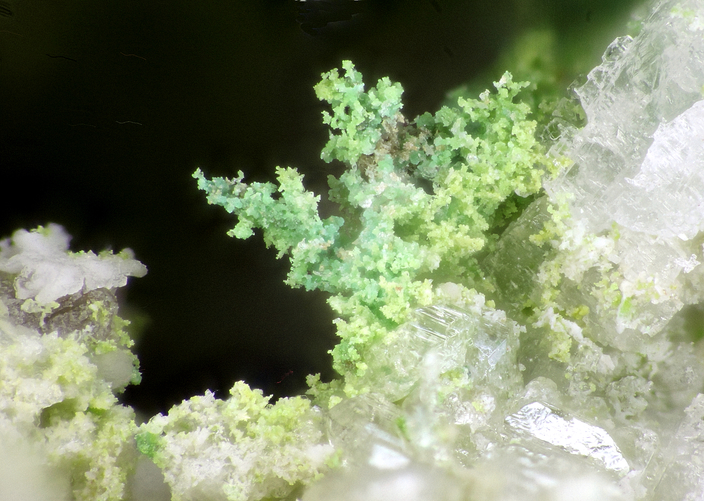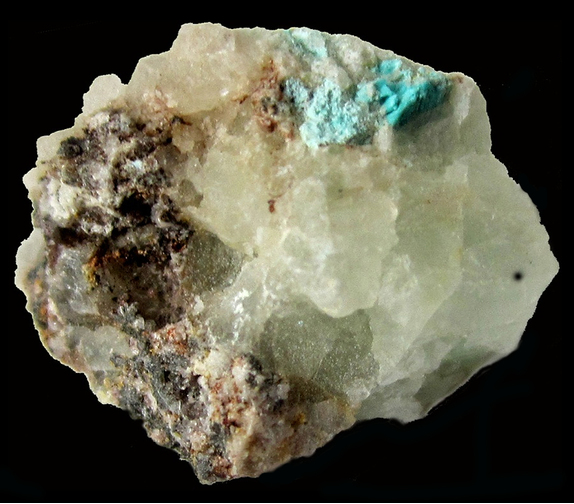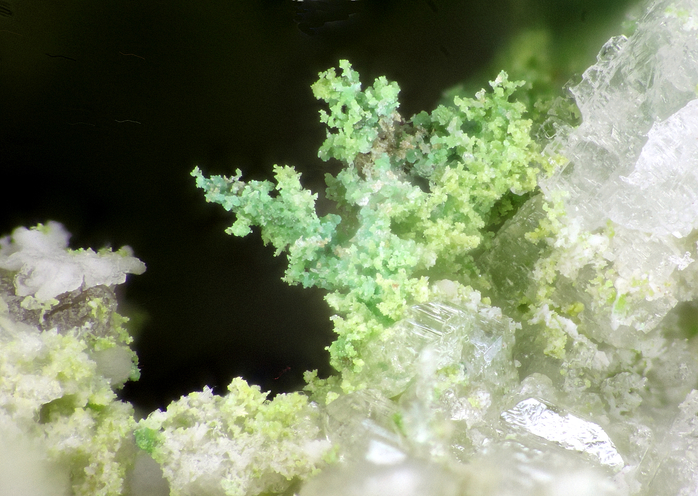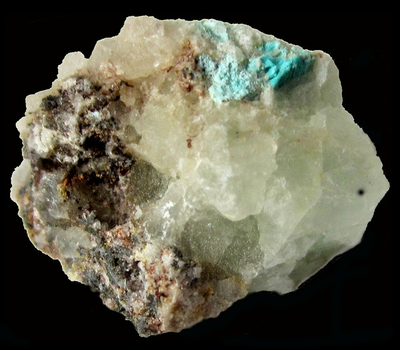Luddenite
A valid IMA mineral species
This page is currently not sponsored. Click here to sponsor this page.
About Luddenite
Formula:
Cu2Pb2Si5O14 · 4H2O
Colour:
Translucent nickel green
Hardness:
4
Specific Gravity:
4.45
Crystal System:
Monoclinic
Name:
Named in honor of Raymond W. Ludden (August 1919 - 1 April 2015) the chief geologist for Western Exploration, Phelps Dodge Corporation.
This page provides mineralogical data about Luddenite.
Unique Identifiers
Mindat ID:
2450
Long-form identifier:
mindat:1:1:2450:7
GUID
(UUID V4):
(UUID V4):
eb126ef8-c751-4b8a-9529-5b58895c0e55
IMA Classification of Luddenite
Approved
IMA Formula:
Cu2Pb2Si5O14 · 14H2O
First published:
1982
Classification of Luddenite
9.HH.10
9 : SILICATES (Germanates)
H : Unclassified silicates
H : With Pb
9 : SILICATES (Germanates)
H : Unclassified silicates
H : With Pb
78.7.11.1
78 : Unclassified Silicates
7 :
78 : Unclassified Silicates
7 :
14.13.3
14 : Silicates not Containing Aluminum
13 : Silicates of Pb
14 : Silicates not Containing Aluminum
13 : Silicates of Pb
Mineral Symbols
As of 2021 there are now IMA–CNMNC approved mineral symbols (abbreviations) for each mineral species, useful for tables and diagrams.
| Symbol | Source | Reference |
|---|---|---|
| Ldd | IMA–CNMNC | Warr, L.N. (2021). IMA–CNMNC approved mineral symbols. Mineralogical Magazine, 85(3), 291-320. doi:10.1180/mgm.2021.43 |
Physical Properties of Luddenite
Transparency:
Translucent
Colour:
Translucent nickel green
Streak:
Pale nickel green
Hardness:
4 on Mohs scale
Cleavage:
Distinct/Good
The plane of flattening is a cleavage plane.
The plane of flattening is a cleavage plane.
Density:
4.45 g/cm3 (Measured) 4.98 g/cm3 (Calculated)
Optical Data of Luddenite
Type:
Biaxial (+)
RI values:
nα = 1.852 nγ = 1.867
2V:
Measured: 40°
Max Birefringence:
δ = 0.015

Image shows birefringence interference colour range (at 30µm thickness)
and does not take into account mineral colouration.
and does not take into account mineral colouration.
Surface Relief:
Moderate
Dispersion:
none
Pleochroism:
Visible
Comments:
gamma=rich emerald green, alpha = beta = yellow green.
Chemistry of Luddenite
Mindat Formula:
Cu2Pb2Si5O14 · 4H2O
Common Impurities:
Ti
Crystallography of Luddenite
Crystal System:
Monoclinic
Cell Parameters:
a = 7.85 Å, b = 20.06 Å, c = 14.72 Å
β = 90.78°
β = 90.78°
Ratio:
a:b:c = 0.391 : 1 : 0.734
Unit Cell V:
2,317.76 ų (Calculated from Unit Cell)
Z:
4
Morphology:
Grains not exceeding 0.01 mm in size. They form in rosettes or fan-shaped aggregates closely packed together. Where individual grains can be discerned, they are scales or plates with wedge-shaped terminations.
Twinning:
Twinned on a plane normal to the cleavage.
Comment:
Point Group: n.d.; Space Group: n.d.
X-Ray Powder Diffraction
Powder Diffraction Data:
| d-spacing | Intensity |
|---|---|
| 7.361 Å | (100) |
| 3.173 Å | (100) |
| 2.918 Å | (80) |
| 5.218 Å | (70) |
| 4.226 Å | (50) |
| 3.515 Å | (50) |
| 3.411 Å | (50) |
Geological Environment
Paragenetic Mode(s):
| Paragenetic Mode | Earliest Age (Ga) |
|---|---|
| Stage 7: Great Oxidation Event | <2.4 |
| 47a : [Near-surface hydration of prior minerals] |
Type Occurrence of Luddenite
General Appearance of Type Material:
Microcrystalline, individual grains not exceeding 0.01 mm in size.
Place of Conservation of Type Material:
The Natural History Museum, London, England, 1984,473-474.
Geological Setting of Type Material:
Oxidized Cu-Zn ores.
Associated Minerals at Type Locality:
Reference:
Williams, S. A. (1982). Luddenite, a new copper-lead silicate from Arizona. Mineralogical Magazine, 46(340), 363-364.
Synonyms of Luddenite
Other Language Names for Luddenite
Common Associates
Associated Minerals Based on Photo Data:
| 1 photo of Luddenite associated with Wickenburgite | CaPb3Al2Si10O24(OH)6 |
| 1 photo of Luddenite associated with Linarite | PbCu(SO4)(OH)2 |
| 1 photo of Luddenite associated with Galena | PbS |
| 1 photo of Luddenite associated with Alamosite | PbSiO3 |
| 1 photo of Luddenite associated with Chrysocolla | Cu2-xAlx(H2-xSi2O5)(OH)4 · nH2O, x < 1 |
Related Minerals - Strunz-mindat Grouping
| 9.HH.05 | Macquartite | Cu2Pb7(CrO4)4(SiO4)2(OH)2 |
| 9.HH.15 | Creaseyite | Pb2Cu2Fe3+2(Si4.67Al0.33)O15.33(OH)3 · H2O |
| 9.HH.20 | Plumbotsumite | Pb13(CO3)6(Si10O27) · 3H2O |
| 9.HH.25 | Molybdophyllite | Pb8Mg9[Si10O28(OH)8O2(CO3)3] · H2O |
Other Information
Notes:
Luddenite is not easily soluble in acids. Dissolution even in heated 50 % HNO3 was slow. It readily fuses to a runny lemon yellow slag in the closed tube.
Health Risks:
No information on health risks for this material has been entered into the database. You should always treat mineral specimens with care.
Internet Links for Luddenite
mindat.org URL:
https://www.mindat.org/min-2450.html
Please feel free to link to this page.
Please feel free to link to this page.
Search Engines:
External Links:
Mineral Dealers:
References for Luddenite
Localities for Luddenite
Locality List
 - This locality has map coordinates listed.
- This locality has map coordinates listed.
 - This locality has estimated coordinates.
ⓘ - Click for references and further information on this occurrence.
? - Indicates mineral may be doubtful at this locality.
- This locality has estimated coordinates.
ⓘ - Click for references and further information on this occurrence.
? - Indicates mineral may be doubtful at this locality.
 - Good crystals or important locality for species.
- Good crystals or important locality for species.
 - World class for species or very significant.
(TL) - Type Locality for a valid mineral species.
(FRL) - First Recorded Locality for everything else (eg varieties).
- World class for species or very significant.
(TL) - Type Locality for a valid mineral species.
(FRL) - First Recorded Locality for everything else (eg varieties).
All localities listed without proper references should be considered as questionable.
Austria | |
| Brandstätter et al. (2010) |
Germany | |
| www.mineralienatlas.de (n.d.) +1 other reference |
USA | |
| |
| Williams (1982) |
| Williams (1982) +1 other reference |
| Anthony et al. (1995) |
Quick NavTopAbout LuddeniteUnique IdentifiersIMA Classification Classification Mineral SymbolsPhysical Properties Optical Data Chemistry Crystallography X-Ray Powder DiffractionGeological EnvironmentType Occurrence SynonymsOther LanguagesCommon AssociatesStrunz-MindatOther InformationInternet Links References Localities Locality List





 symbol to view information about a locality.
The
symbol to view information about a locality.
The 



Artillery Peak, Artillery Mountains, Mohave County, Arizona, USA